Published on January 11, 2021
Why do vitamin D levels vary among different people taking the same supplemental dose?
 There are several factors including the intake of certain nutrients that influence how an individual’s vitamin D level responds to their vitamin D supplementation amount (this is called the dose-response). It is because of these different factors between individuals that there is such a wide range of serum level responses that can be produced at any specific supplementation amount. For example, it is possible for a supplemental intake of 4000 IU/day to result in a vitamin D serum level of 25 ng/ml (62.5 nmol/L) in one individual, and 60 ng/ml (150 nmol/L) in another. Testing vitamin D levels, versus blind supplementation, is therefore essential to know for sure if what you are taking is the right amount for you.
There are several factors including the intake of certain nutrients that influence how an individual’s vitamin D level responds to their vitamin D supplementation amount (this is called the dose-response). It is because of these different factors between individuals that there is such a wide range of serum level responses that can be produced at any specific supplementation amount. For example, it is possible for a supplemental intake of 4000 IU/day to result in a vitamin D serum level of 25 ng/ml (62.5 nmol/L) in one individual, and 60 ng/ml (150 nmol/L) in another. Testing vitamin D levels, versus blind supplementation, is therefore essential to know for sure if what you are taking is the right amount for you.
Today we explore how some of these other nutrients contribute to the variability in the vitamin D dose-response.
What Are Co-Nutrients?
Previously, we have discussed how a lack of key vitamin D co-nutrients can keep vitamin D levels from rising. What are co-nutrients and how are they important for vitamin D levels?
Co-nutrients are nutrients that work together for some process. If one co-nutrient is limited, either missing or not plentiful enough, then the process might also be limited. For example, your body needs magnesium to process and use vitamin D; without sufficient magnesium, the amount of vitamin D that can be metabolized by your body is limited.
Some examples of nutrients that seem to have an influence on vitamin D levels can be seen below. In the first chart, using the data provided for the GrassrootsHealth study from almost 3,000 participants with supplemental magnesium and vitamin K2 information, we plotted every participant’s supplemental vitamin D intake (dose) and blood level (response) and determined the average trends for participants who reported taking no supplemental magnesium or vitamin K2, those who reported usually taking both supplemental magnesium and vitamin K2, and those who reported taking only one or the other.
Vitamin D Dose-Response by Magnesium and Vitamin K2 Intake
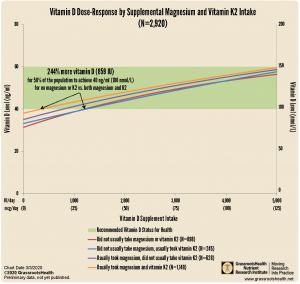
On average, those taking both supplemental magnesium and vitamin K2 have a higher vitamin D level for any given vitamin D intake amount than those taking either supplemental magnesium or vitamin K2 or neither. Specifically, 244% more supplemental vitamin D was needed for 50% of the population to achieve 40 ng/ml (100 nmol/L) for those not taking supplemental magnesium or vitamin K2 compared to those who usually took both supplemental magnesium and vitamin K2.
Vitamin D Dose-Response by Magnesium Intake
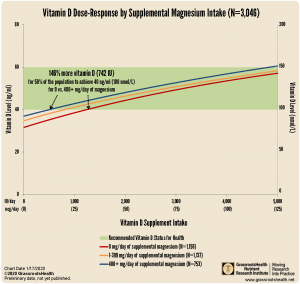
On average, those taking more supplemental magnesium have a higher vitamin D level for any given vitamin D intake amount than those taking less supplemental magnesium. Specifically, 146% more supplemental vitamin D was needed for 50% of the population to achieve 40 ng/ml (100 nmol/L) for those not taking supplemental magnesium compared to those who took 400 mg/day or more.
Vitamin D Dose-Response by Vitamin K2 Intake
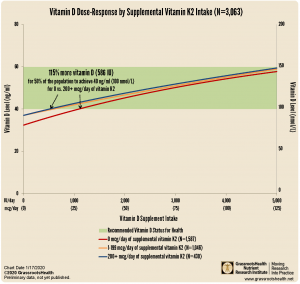
On average, those taking supplemental vitamin K2 have a higher vitamin D level for any given vitamin D intake amount than those not taking supplemental vitamin K2. Specifically, 115% more supplemental vitamin D was needed for 50% of the population to achieve 40 ng/ml (100 nmol/L) for those not taking supplemental vitamin K2 compared to those who took 200 mcg/day or more. The trend lines for both supplemental vitamin K2 intake amounts (1-199 and 200+ mcg/day) were similar.
Vitamin D Dose-Response by Calcium Intake
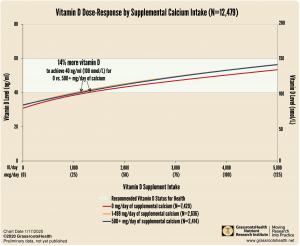 On average, those taking supplemental calcium have a slightly higher vitamin D level for any given vitamin D intake amount than those not taking supplemental calcium. The trend lines for both supplemental calcium intake amounts (1-499 and 500+ mg/day) were similar. Specifically, 14% more supplemental vitamin D was needed for 50% of the population to achieve 40 ng/ml (100 nmol/L) for those not taking supplemental calcium compared to those who took 500 mg/day or more.
On average, those taking supplemental calcium have a slightly higher vitamin D level for any given vitamin D intake amount than those not taking supplemental calcium. The trend lines for both supplemental calcium intake amounts (1-499 and 500+ mg/day) were similar. Specifically, 14% more supplemental vitamin D was needed for 50% of the population to achieve 40 ng/ml (100 nmol/L) for those not taking supplemental calcium compared to those who took 500 mg/day or more.
Vitamin D Dose-Response by Vitamin B6 Intake
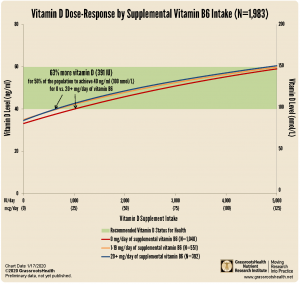 On average, those taking supplemental vitamin B6 have a higher vitamin D level for any given vitamin D intake amount than those not taking supplemental vitamin B6. Specifically, 63% more supplemental vitamin D was needed for 50% of the population to achieve 40 ng/ml (100 nmol/L) for those not taking supplemental vitamin B6 compared to those who took 20 mg/day or more. The trend lines for both supplemental vitamin B6 intake amounts (1-19 and 20+ mg/day) were similar.
On average, those taking supplemental vitamin B6 have a higher vitamin D level for any given vitamin D intake amount than those not taking supplemental vitamin B6. Specifically, 63% more supplemental vitamin D was needed for 50% of the population to achieve 40 ng/ml (100 nmol/L) for those not taking supplemental vitamin B6 compared to those who took 20 mg/day or more. The trend lines for both supplemental vitamin B6 intake amounts (1-19 and 20+ mg/day) were similar.
Vitamin D Dose-Response by Vitamin B12 Intake
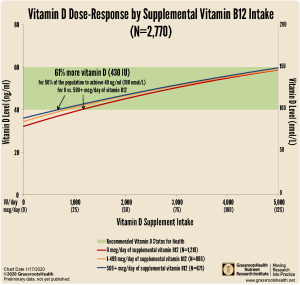 On average, those taking supplemental vitamin B12 have a higher vitamin D level for any given vitamin D intake amount than those not taking supplemental vitamin B12. Specifically, 61% more supplemental vitamin D was needed for 50% of the population to achieve 40 ng/ml (100 nmol/L) for those not taking supplemental vitamin B12 compared to those who took 500 mcg/day or more. The trend lines for both supplemental vitamin B12 intake amounts (1-499 and 500+ mcg/day) were similar.
On average, those taking supplemental vitamin B12 have a higher vitamin D level for any given vitamin D intake amount than those not taking supplemental vitamin B12. Specifically, 61% more supplemental vitamin D was needed for 50% of the population to achieve 40 ng/ml (100 nmol/L) for those not taking supplemental vitamin B12 compared to those who took 500 mcg/day or more. The trend lines for both supplemental vitamin B12 intake amounts (1-499 and 500+ mcg/day) were similar.
Vitamin D Dose-Response by Vitamin C Intake
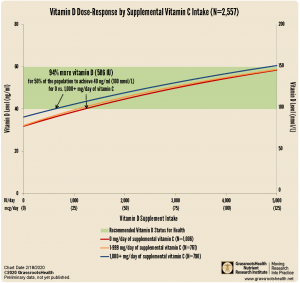 On average, those taking supplemental vitamin C in the amount of 1,000 mg/day or more have a higher vitamin D level for any given vitamin D intake amount than those taking less supplemental vitamin C. Specifically, 94% more supplemental vitamin D was needed for 50% of the population to achieve 40 ng/ml (100 nmol/L) for those not taking supplemental vitamin C compared to those who took 1,000 mg/day or more. The trend lines were similar for those taking no supplemental vitamin C and those taking 1-999 mg/day.
On average, those taking supplemental vitamin C in the amount of 1,000 mg/day or more have a higher vitamin D level for any given vitamin D intake amount than those taking less supplemental vitamin C. Specifically, 94% more supplemental vitamin D was needed for 50% of the population to achieve 40 ng/ml (100 nmol/L) for those not taking supplemental vitamin C compared to those who took 1,000 mg/day or more. The trend lines were similar for those taking no supplemental vitamin C and those taking 1-999 mg/day.
Vitamin D Dose-Response with Probiotic Intake
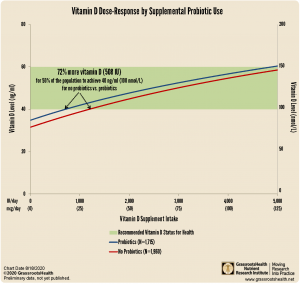 This preliminary analysis shows that on average, those taking supplemental probiotics have a higher vitamin D level for any given vitamin D intake amount than those not taking supplemental probiotics. Specifically, 72% more supplemental vitamin D was needed for 50% of the population to achieve 40 ng/ml (100 nmol/L) for those did not take probiotics compared to those who did.
This preliminary analysis shows that on average, those taking supplemental probiotics have a higher vitamin D level for any given vitamin D intake amount than those not taking supplemental probiotics. Specifically, 72% more supplemental vitamin D was needed for 50% of the population to achieve 40 ng/ml (100 nmol/L) for those did not take probiotics compared to those who did.
Other Vitamin D Co-Nutrients
A lack of other key vitamin D co-factors, such as boron and zinc, can reduce vitamin D absorption and production. On the other hand, a high intake of certain vitamins that compete with vitamin D, such as vitamin A in the form of retinol or retinyl palmitate (not beta-carotene), can cause a reduction in vitamin D levels. This form of vitamin A is found in food from animal sources (especially liver) and some supplements. Also, some drugs including statins, prednisone and weight-loss drugs can block vitamin D.
Don’t Forget Other Factors that Affect Vitamin D Levels!
Since vitamin D is a fat-soluble vitamin, taking it with a meal that contains fat can increase absorption. With increased age comes a reduced ability to produce vitamin D in the skin in response to UVB exposure and a reduction in the kidney’s ability to convert vitamin D to its active form. Also, smokers and those with a high BMI tend to have lower levels. Certain medical and health conditions (including pregnancy) can increase your use of and requirement for vitamin D. Food, UVB exposure, and skin color also contribute to variability in vitamin D levels.
Lastly, it has been shown that vitamin D levels change naturally throughout the day, tending to be up to 20% higher mid-day than in the morning or evening, especially when taking a supplement. For those tracking their vitamin D levels over time, it is strongly recommended to collect your blood sample at the same time of day to have comparable results.
How is Your Body Responding to Vitamin D Supplementation?
If you have been consistently taking the same supplemental dose of vitamin D and experience a lower than expected vitamin D level, it’s possible that a change in diet, behavior, health, or the environment over the prior few months could have reduced your levels. Or, if you are having difficulty increasing your levels, try increasing your dose, taking it with your largest meal, and optimizing vitamin D co-factors to improve your levels. Testing and re-testing after making your adjustments is the only way to tell if what you are doing is helping you to achieve your target level of vitamin D. Test today.
By joining the GrassrootsHealth projects, you are not only contributing valuable information to our study, but you are also gaining knowledge about how you could improve your own health through measuring and tracking your nutrient status, and educating yourself on how to improve it. Do you know what your status of vitamin D, omega-3s, and other essential nutrients is? Could your levels be improved? Test now to find out!






